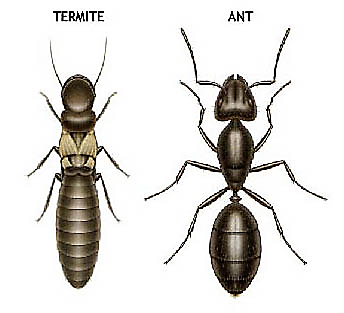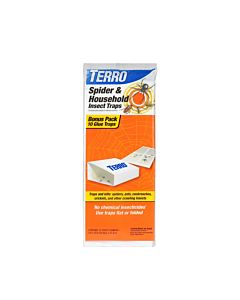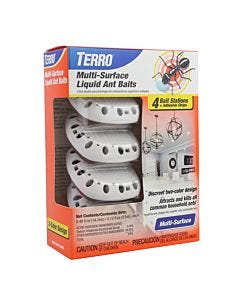HOW TO KILL CARPENTER ANTS
If you are encountering large ants around decaying wood or in your home, the culprits are most likely carpenter ants, scientifically known as Camponotus. Contrary to popular belief, carpenter ants don’t actually eat wood! These tiny annoyances enjoy carving straight, clean tunnels through lumber to construct their colony. There are over two hundred species that vary in appearance and some are only found in certain regions of the country.
What do they look like?

There are many different types of carpenter ants, which makes diagnosing your infestation by appearance alone quite tricky. Since most carpenter ants in the U.S. share some common physical features, you can begin by checking for certain characteristics to distinguish them from other types of ants:
Size: these pests can range from 3/8 inch to one inch in length; however, some species can be as small as the common house ant.
Body shape: this is the most important feature to focus on when detecting what your ant guests are. Look for one node segmenting the waist and an evenly rounded top surface on the thorax (the first body portion behind the head). Other ant species will have a bumpy upper thorax.
Color: they are typically black but can also be red or yellow with black rings; this varies depending upon regional location.
Regional Classification
Carpenter ants are picky about where they live, so understanding which ants are specific to your general area can also aid in the identification process.
East coast: home to the black carpenter ant.
Physical appearance: as the name implies, they are black and have the traditional one-node segment. The upper thorax is smooth and they can range from ¼ inch to ½ inch in length.
Nest site: look in places that have moist or decaying wood, damaged trees, logs and stumps.
West coast: home to the western carpenter ant.
Physical appearance: look for a dull black body with reddish legs, a one-node segment and smooth upper thorax. They range from ¼ inch to ½ inch in length.
Nest site: western carpenter ants love moist or decaying wood, especially tree stumps or logs. They can also nest in hard wood, but this seldom happens.
Northwest: home to the carpenter ant.
Physical appearance: these guys are black with a red thorax, a one-node segment and the typical smooth thorax. Like most carpenter ants, they can be as long as ½ inch.
Nest site: rotting wood is their main choice especially if there is fungus or moisture damage. They can also nest outside in trees, stumps or under rocks and logs.
How do I distinguish carpenter ants from termites?

These lumber-loving ants can often be mistaken for termites because they mutually share a passion for destroying wood. Termites are famous for these features:
Physical appearance: look for a creamy white color, undivided waist, straight antennae and wings of equal length.
Behavior: these bugs are like vampires in the sense that they hate light and rarely leave their nests.
Food: unlike carpenter ants, wood is a termite’s main source of fuel. They build tunnels to their home out of saliva, mud and fecal matter; this is typically seen near the home’s foundation.
Where do I find them?
Carpenter ants stay true to their name and prefer to establish home in some form of rotting wood, but this can vary depending on the type of colony. There are two main types of carpenter ant nests:

Parent colonies: these can be discovered outside in all varieties of rotting wood: trees, stumps, roots, boards and logs. Since moist and decaying wood can easily be found inside, carpenter ants won’t hold back from infesting those areas as well. Investigate the wood around your windows and check behind sinks, showers, dishwashers and tile. They can also make cozy homes in your abandoned attic and under roofing or subfloors.
Satellite colonies: these nests originate from the parent colonies and are inhabited by workers and mature larvae. You will discover them in more dry locations, including hollow doors and insulation. The workers are always on the move, traveling from the satellite colony to the parent colony.
How do I detect the location of a nest?
The first step to abolishing your carpenter ant problem is to track down the nest. This can be done in several ways:
 Look for places with constant moisture: damp wood eventually rots and is a goldmine for carpenter ants. Check in problem areas and you will hit the jackpot!
Look for places with constant moisture: damp wood eventually rots and is a goldmine for carpenter ants. Check in problem areas and you will hit the jackpot! Look for piles of sawdust: these mounds won’t be far from the source, so if you find sawdust, the nest is close by.
Look for piles of sawdust: these mounds won’t be far from the source, so if you find sawdust, the nest is close by. Listen: if disturbed, carpenter ants make a rustling sound with their mouths to communicate with each other. Tap the area where you think they live, and simply listen.
Listen: if disturbed, carpenter ants make a rustling sound with their mouths to communicate with each other. Tap the area where you think they live, and simply listen. Follow them back to the nest: this plan must be executed in the evening after sunset, since this is when the culprits are most active. Choose a sweet food such as honey to lure them in, and try not to startle them with light, by covering the flashlight lens with a red film or your hand.
Follow them back to the nest: this plan must be executed in the evening after sunset, since this is when the culprits are most active. Choose a sweet food such as honey to lure them in, and try not to startle them with light, by covering the flashlight lens with a red film or your hand.Now that you have found the nest, true extermination can take place.
How do I get rid of them?
Now that you have found the nest, you are ready to take it out! There are a variety of termination methods, depending upon what type of invasion you are dealing with.

 Sprays: these can be used indoors or outdoors and work best if the nest is exposed. The TERRO® carpenter ant sprays are also effective on termites, so if you can’t identify which wood-destroying creature you’re dealing with, they will get the job done either way. Liquid bait: under certain conditions, baiting can be very successful.
Sprays: these can be used indoors or outdoors and work best if the nest is exposed. The TERRO® carpenter ant sprays are also effective on termites, so if you can’t identify which wood-destroying creature you’re dealing with, they will get the job done either way. Liquid bait: under certain conditions, baiting can be very successful.
TERRO® liquid ant baits appeal to ants with a sweet tooth, and carpenter ants only have an occasional craving for sugar. If they are in a feeding cycle for sweets, baiting will work magic. The feeding workers take the toxin back to the nest and share it with the others, successfully taking out the entire colony.
How to prevent future infestations?
The carpenter ants are finally gone, and you are just one step away from living an ant-free life. Preventing against further infestations will spare you the effort of eliminating yet another carpenter ant intrusion.
Take care of problem areas: keep damp and decaying wood to a minimum, so if you have a pile of firewood outside, try covering it with a tarp or moving it inside to keep it dry. If wood is exposed to moisture, apply constant air circulation so it stays dry.
Trees: clean up tree roots and stumps in the yard, and prune tree branches so they stay away from the house. Carpenter ants can easily travel from a branch to your house and start an infestation there.
Perimeter sprays: these sprays work great to keep ants and other bugs, such as spiders, out of your home during the winter when they want to move inside.
Not Yet Satisfied?
- Learn more about Spiders in our Insect Library
- Continue to our Carpenter Ant Control Products »
References:
Backed by Bayer - And ID Guide




